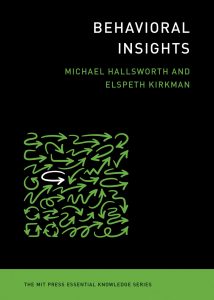In Behavioral Insights, Michael Hallsworth and Elspeth Kirkman offer a pragmatic and engaging new overview of behavioural informed design, exploring its history, application, limitations and its future possibilities. Gee Connolly recommends the book to anyone looking for a succinct and clear summary of the behavioural insights approach as well as tangible techniques for applying insights to real-world scenarios.
Behavioral Insights (MIT Press Essential Knowledge Series). Michael Hallsworth and Elspeth Kirkman. MIT Press. 2020.
 Find this book (affiliate link):
Find this book (affiliate link): ![]()
Newcomers to behavioural public policy have a new book to get a first dip into the field. Behavioral Insights is a pragmatic and engaging overview of behavioural informed design, its history, application in practice, criticisms and limitations and its future possibilities. Michael Hallsworth and Elspeth Kirkman are leading experts in the field and draw on their work within the Behavioural Insights Team (Nudge Unit) to clearly illustrate how behavioural insights can be applied to policy. I would highly recommend this book to anyone looking for a succinct and clear summary of the behavioural insights approach as well as tangible techniques for applying insights to real-world scenarios.
In Chapters One and Two, Hallsworth and Kirkman describe the (relatively short) history of behavioural insights, and how this approach has developed from traditional schools of thought, such as homo economicus and psychological analysis of ‘thinking fast and slow’. Their references to Plato’s language of ‘framing’ and Francis Bacon’s description of ‘confirmation bias’ help to illustrate that the behavioural insights approach is not necessarily ground-breaking, but rather an acknowledgement of the complex (and oftentimes irrational) nature of human behaviour. Furthermore, important behavioural economics literature (such as the work of Richard Thaler, Cass Sunstein and Dan Ariely) is well signposted and referenced throughout.

Image Credit: Pixabay
That said, as Hallsworth and Kirkman acknowledge in Chapter Six, a clear definition of behavioural insights has yet to be established. This somewhat detracts from the otherwise clearly explained introduction and history of concepts in Chapters One and Two, particularly given Hallsworth and Kirkman do not suggest how an encompassing definition might be achieved. Additionally, including more examples of how behavioural insights have been applied in practice in Chapter Three would be valuable to novice readers in the behavioural insights field.
In Chapter Four, Hallsworth and Kirkman outline how their team applied the behavioural insights approach to the real-world challenge of increasing the attendance of unemployed people at jobseekers’ events. This section will likely be very useful to professionals working in service design and policy roles as it is clearly laid out and easy to navigate, offering various diagrams and frameworks that can be used to map individual behaviours and signposting ‘user’ journeys throughout.
Chapter Four could be improved if these frameworks were named and attached as an appendix to the book, creating takeaway snippets readers could easily apply within their own policy or business setting. Furthermore, applying the behavioural insights approach in one or two more examples would have been beneficial, in order to demonstrate how this methodology can be adapted depending on context, amongst other constraints. On the other hand, adding more examples would perhaps counteract the succinct and focused nature of the book, factors which make it so accessible. Behavioral Insights strikes a nice balance between the step-by-step application of behavioural insights and acknowledging its surrounding complexity.
Chapter Five provides a great summary of some of the limitations of applying behavioural insights including those of ethics, scaling-up and scientific evidence. This chapter specifically gives frameworks for evaluating the transparency and manipulation of a behavioural informed policy, products or services, which will likely be useful to those working in these industries.
Unfortunately, the limitations outlined in Chapter Five are not developed cohesively into Chapter Six, which considers the future of behavioural insights. Chapter Six is less well-structured and arguably leaves the reader with more questions than answers, though some interesting ideas relating to human-centred design and complex network analysis are put forward. Nonetheless, including such a free-flowing and open-ended chapter does help to empower the reader to adapt the proposed behavioural insights approach to their own context and to investigate other emerging techniques.
The book’s concluding statement that behavioural insights may someday ‘become meaningless’ due to them ‘being absorbed into standard ways of working’ deserves some interrogation, which was perhaps the prerogative of the authors. Hallsworth and Kirkman make a persuasive case for embedding behavioural practices in public policymaking and industry. However, their earlier reflections on the ethics of liberal paternalism, the need for a systematic approach to developing and evaluating behavioural policies and new and emerging behavioural informed design techniques, for me, underlined the need to always delineate where and how behavioural insights have been applied. This is particularly the case where there is a risk that behavioural insights may be used for coercion or deception, otherwise known as ‘sludge’. This closing thought therefore felt somewhat in contradiction to earlier statements in this otherwise thoughtfully set out short read.
Overall Behavioral Insights provides a pedagogic overview of behavioural insights and how they can be applied in practice. It’s pragmatically written and ideal for anyone working in a business, policy or service design context looking to get quick insights they can apply in their day-to-day work. Perhaps because it is a short book, Behavioral Insights could have expanded the number of examples of how behavioural insights can be applied in practice, providing an appendix of key frameworks and re-structuring Chapter Six to make Hallsworth and Kirkman’s proposed next steps within the field more tangible. Regardless, I am looking forward to experimenting with their frameworks in my own professional activities. Though I cannot guarantee my opinions haven’t fallen victim to confirmation bias, so I guess you’ll have to check the book out yourself!
- This review first appeared at LSE Review of Books.
Please read our comments policy before commenting.
Note: This article gives the views of the author, and not the position of USAPP – American Politics and Policy, nor of the London School of Economics.
Shortened URL for this post: https://bit.ly/3o88rLE
About the reviewer
Gee Connolly – London School of Economics and London School of Hygiene and Tropical Medicine
Gee Connolly is undertaking an MSc in Health Policy, Planning and Financing at the London School of Economics and London School of Hygiene and Tropical Medicine. She also works as a Product Owner for a Healthtech delivering a combined drug and digital medical device, aimed at supporting patient self-management and personalised care. Her research interests lie in patient activation, personalised care, behavioural incentive design and public health, innovation and change management, and ageing populations.



